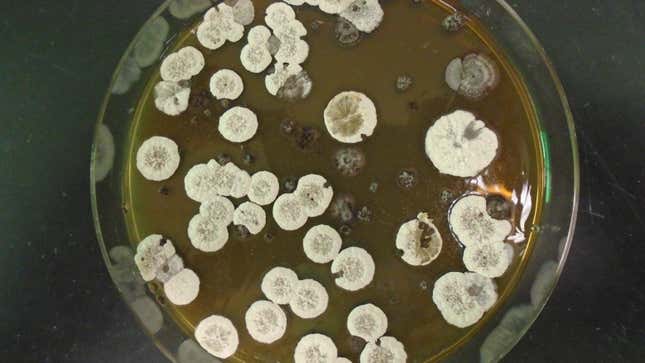
A popular rocket fuel called RP-1 gets its name from its key ingredient: refined petroleum. Research published last week in the journal Joule suggests a potentially cleaner and more powerful ingredient: a molecule produced by the Streptomyces bacteria. The proposed fuel won’t be ready any time soon, but the new research points to this intriguing possibility.
Streptomyces produces anti-fungal molecules called POP-FAMEs, otherwise known as polycylcopropanated fatty acid methyl esters. POP-FAMEs feature carbon rings made up of three carbon molecules bonded together into tight triangles with 60-degree angles. The scientists behind the new study reasoned that this carbon geometry might be superior to conventional approaches to fuel, and for two main reasons.
Because the carbon geometry in a POP-FAME is more compact than those found in preexisting fuels, it allows a greater number of molecules to fill the same amount of space. What’s more, acute angles within POP-FAMEs place stress on the carbon bonds, and this stress, the researchers surmised, could be a major source of potential energy and with a cleaner production process.
“This biosynthetic pathway provides a clean route to highly energy-dense fuels that, prior to this work, could only be produced from petroleum using a highly toxic synthesis process,” said author Jay Keasling in a press release. Keasling is a professor of chemistry at the University of California at Berkeley and is the CEO of the Joint BioEnergy Institute (JBEI)—a Department of Energy research center. “As these fuels would be produced from bacteria fed with plant matter—which is made from carbon dioxide pulled from the atmosphere—burning them in engines will significantly reduce the amount of added greenhouse gas relative to any fuel generated from petroleum.”
That this proposed biofuel will be environmentally safer than conventional fuels is no guarantee. We have no way of knowing the potential ways in which the production process of this fuel might be harmful, at least not until a scaled-up production process is up and running. It’s important to point out that not all biofuels are eco-friendly.
While three-carbon rings aren’t necessarily rare, the researchers could only find two examples identified in previous research, both in the form of molecules produced by Streptomyces. The issue, they say, is that Streptomyces is nearly impossible to grow in a lab environment. Thankfully, one of the molecules had been analyzed in a previous genetics study, which allowed the researchers to grow the POP-FAMEs from scratch once they identified the enzymes responsible for its production.
Computer simulations of the lab-grown molecule indicated that POP-FAMEs could have an energy density of 50 megajoules per liter, while RP-1 features an energy density of 35 megajoules per liter. That’s obviously a substantial improvement—at least in theory. Indeed, even though the researchers were able to estimate the energy density of the POP-FAME, Keasling and the team are still far away from any large scale testing.
“You need 10 kilograms of fuel to do a test in a real rocket engine, and we’re not there yet,” said co-author Pablo Cruz-Morales from the Lawrence National Laboratory and University of California Berkeley.
Regardless, these preliminary results seem promising, and it could eventually result in more efficient rocket fuel while simultaneously reducing the aerospace industry’s reliance on petroleum.
More: Rocket Launches Could Be Polluting Our Atmosphere in New and Unexpected Ways.